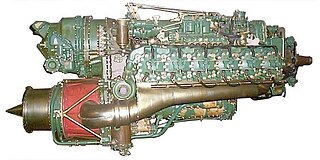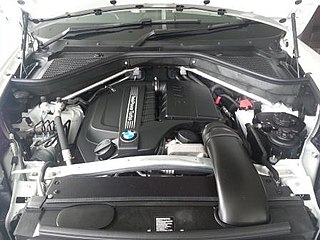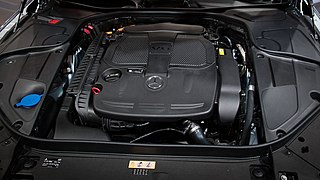Related Research Articles

In an internal combustion engine, a turbocharger is a forced induction device that is powered by the flow of exhaust gases. It uses this energy to compress the intake air, forcing more air into the engine in order to produce more power for a given displacement.

A V6 engine is a six-cylinder piston engine where the cylinders share a common crankshaft and are arranged in a V configuration.

Garrett Motion Inc., formerly Honeywell Transportation Systems and Honeywell Turbo Technologies, is an American company primarily involved in engineering, development and manufacturing of turbochargers and related forced induction systems for ground vehicles from small passenger cars to large trucks and industrial equipment and construction machinery. It originated as part of Garrett AiResearch's Industrial Division in Phoenix, Arizona, in 1954, after which they entered a contract to provide 5,000 turbochargers for the Caterpillar mining vehicle. It manufactured turbochargers for railroads and commercial trucks. The business produced approximately $3.6 billion in revenue in 2021. Garrett Motion is also involved in motorsports providing turbochargers and forced induction systems, solutions and related equipment to racing teams and various forms of automobile racing and professional competitions. In 2004, the business became part of American industrial conglomerate Honeywell International, Inc., as their Transportation Systems division. In 2018, it was spun off to become an independent company under the Garrett Motion name with corporate headquarters in Rolle, Switzerland.

Alpina Burkard Bovensiepen GmbH & Co. KG is an automobile manufacturing company based in Buchloe, in the Ostallgäu district of Bavaria, Germany that develops and sells high-performance versions of BMW cars. Alpina works closely with BMW and their processes are integrated into BMW's production lines, and is recognized by the German Ministry of Transport as an automobile manufacturer, in contrast to other performance specialists, which are aftermarket tuners. The Alpina B7 is produced at the same assembly line in Dingolfing, Germany, as BMW's own 7 Series. The B7's twin-turbo 4.4-litre V8 is assembled by hand at Alpina's facility in Buchloe, Germany, before being shipped to BMW for installation, and the assembled vehicle is then sent back to Alpina for finishing touches.
In an internal combustion engine, twin-turbo is a layout in which two turbochargers work in tandem to compress the intake fuel/air mixture. The most common layout features two identical or mirrored turbochargers in parallel, each processing half of a V engine's produced exhaust through independent piping. The two turbochargers can either be matching or different sizes.

Prince is the codename for a family of straight-four 16-valve all-aluminium gasoline engines with variable valve lift and variable valve timing developed by BMW and PSA Peugeot Citroën. It is a compact engine family of 1.4–1.6 L in displacement and includes most modern features such as gasoline direct injection and turbocharger.
In turbocharged internal combustion engines, a boost controller is a device sometimes used to increase the boost pressure produced by the turbocharger. It achieves this by reducing the boost pressure seen by the wastegate.

The term turbo-diesel, also written as turbodiesel and turbo diesel, refers to any diesel engine equipped with a turbocharger. As with other engine types, turbocharging a diesel engine can significantly increase its efficiency and power output, especially when used in combination with an intercooler.

In an internal combustion engine, a supercharger compresses the intake gas, forcing more air into the engine in order to produce more power for a given displacement.
This article gives an outline of Formula One engines, also called Formula One power units since the hybrid era starting in 2014. Since its inception in 1947, Formula One has used a variety of engine regulations. Formulae limiting engine capacity had been used in Grand Prix racing on a regular basis since after World War I. The engine formulae are divided according to era.

A turbo-compound engine is a reciprocating engine that employs a turbine to recover energy from the exhaust gases. Instead of using that energy to drive a turbocharger as found in many high-power aircraft engines, the energy is instead sent to the output shaft to increase the total power delivered by the engine. The turbine is usually mechanically connected to the crankshaft, as on the Wright R-3350 Duplex-Cyclone, but electric and hydraulic power recovery systems have been investigated as well.

The BMW N63 is a twin-turbocharged petrol V8 engine which has been in production from 2008 to present. The N63 is the world's first production car engine to use a "hot-vee" layout, with the turbochargers located inside the "V" of the engine. It is also BMW's first turbocharged petrol V8 engine. The engine has been widely noted for its mechanical issues, undergoing several recalls.

The BMW N55 is a turbocharged straight-six petrol (gasoline) engine that began production in 2009. The N55 replaced the BMW N54 engine and was introduced in the F07 5 Series Gran Turismo.

An electrically assisted turbocharger (EAT) is an arrangement where an electric motor assists the gas-driven turbocharger in providing forced induction, particular at times when exhaust gas flow is insufficient to produce the desired boost. Some systems integrate the motor inside a turbocharger, while others use a separate electric supercharger.

The Mercedes–Benz M276 engine is a direct injected, gasoline automotive piston V6 engine.
Turbochargers have been used on various petrol engines since 1962, in order to obtain greater power or torque output for a given engine displacement.

The BMW B48 is a turbocharged inline-four petrol engine which replaced the BMW N20 and has been in production since 2014. It was first used in the F56 Mini Hatch and has been used in BMW applications since 2015.
Forced induction in motorcycles is the application of forced induction to a motorcycle engine. Special automotive engineering and human factors considerations exist for the application of forced induction with motorcycles, compared to other forms of motorized transportation.

Ferrari made a series of turbocharged, 1.5-litre, V6 racing engines designed for Formula One; between 1981 and 1988. The engine was first used in the Ferrari 126C, in 1981.

The BMW S68 is a twin-turbocharged V8 engine produced by BMW. Its first use was in the 2022 revised BMW X7 as the M60i. A few weeks after its presentation, BMW showed a study of the XM with a more powerful version of the engine. In addition, the basic version is also used in BMW 760i, BMW X5 M60i, and BMW X6 M60i.
References
- ↑ Scott Evans (June 21, 2021), "What Is a Hot Vee Engine? What makes a V-6 or V-8 engine a "Hot Vee"/"Hot V" and why does it matter?", Motor Trend
- ↑ Evan Williams (December 13, 2018). "Hot Vee Engines: How do They Work?". GMInsideNews .
- ↑ Raphael Orlove (September 9, 2014), "The Coolest 'Hot Vee' Turbo Engines", Jalopnik
- ↑ Brian Silvestro (October 4, 2017), "Here's How "Hot V" Turbocharged Engines Work", Road & Track
- ↑ Brian GRABIANOWSKI (April 4, 2016), "Engines Exposed: The Ludicrous "Hot-V" Engine By Mercedes", Carbuzz